
The giraffe is a large African hoofed mammal belonging to the genus Giraffa. It is the tallest living terrestrial animal and the largest ruminant on Earth. Traditionally, giraffes have been thought of as one species, Giraffa camelopardalis, with nine subspecies. Most recently, researchers proposed dividing them into four extant species due to new research into their mitochondrial and nuclear DNA, and individual species can be distinguished by their fur coat patterns. Seven other extinct species of Giraffa are known from the fossil record.

Stag beetles are a family of about 1,200 species of beetles in the family Lucanidae, currently classified in four subfamilies. Some species grow to over 12 centimetres, but most to about 5 cm (2 in).

The Giraffidae are a family of ruminant artiodactyl mammals that share a common ancestor with deer and bovids. This family, once a diverse group spread throughout Eurasia and Africa, presently comprises only two extant genera, the giraffe and the okapi. Both are confined to sub-Saharan Africa: the giraffe to the open savannas, and the okapi to the dense rainforest of the Congo. The two genera look very different on first sight, but share a number of common features, including a long, dark-coloured tongue, lobed canine teeth, and horns covered in skin, called ossicones.
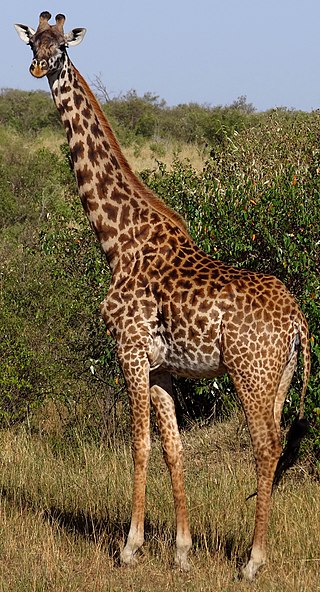
The Masai giraffe, also spelled Maasai giraffe, and sometimes called the Kilimanjaro giraffe, is a species or subspecies of giraffe. It is native to East Africa. The Masai giraffe can be found in central and southern Kenya and in Tanzania. It has distinctive jagged, irregular leaf-like blotches that extend from the hooves to its head. The Masai giraffe is currently the national animal of Tanzania.

The giraffe weevil is a species of small weevil endemic to Madagascar. They are black-bodied and have bright red elytra covering their wings. Giraffe weevils are known for their elongated necks, with the males having necks 2 to 3 times the size of their female counterparts. There are several advantages to their elongated necks, including using them for combat, attracting mates, building nests, and acquiring resources. In the field of coleopterology, giraffe weevils are of interest because they exhibit sexual dimorphism. There are other beetle species that share the common name giraffe weevil, like the New Zealand giraffe weevil Lasiorhynchus barbicornis.

The northern giraffe, also known as three-horned giraffe, is the type species of giraffe, G. camelopardalis, and is native to North Africa, although alternative taxonomic hypotheses have proposed the northern giraffe as a separate species.
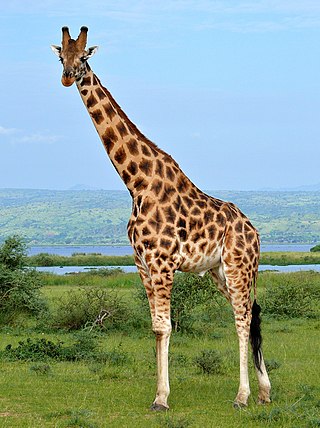
Rothschild's giraffe is an ecotype of the Nubian giraffe. It is one of the most endangered distinct populations of giraffe, with 1,399 mature individuals estimated in the wild in 2018.
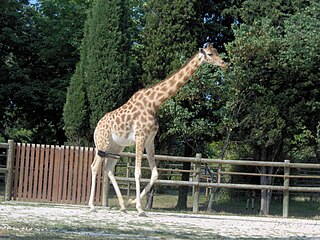
The Kordofan giraffe is a species or subspecies of giraffe found in northern Cameroon, southern Chad, the Central African Republic, and possibly western Sudan. They usually live in tree savannas, bush savannas and thorn savannas. Compared to most other subspecies, the Kordofan giraffe is relatively small at 3.8 to 4.7 meters, with more irregular spots on the inner legs. There are around 2,300 individuals living in the wild. In the wild, female Kordofan giraffes live in loose groups, whilst males live solitary. They have an average lifespan of around 35 years.
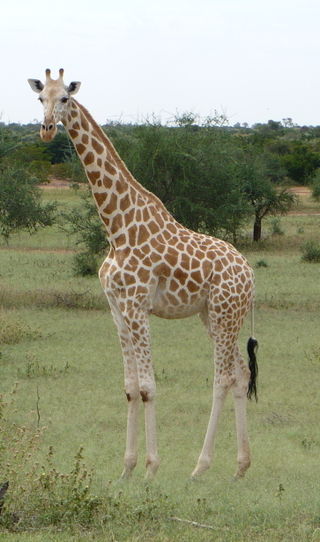
The West African giraffe, also known as the Niger giraffe, is a species or subspecies of the giraffe distinguished by its light colored spots. Its last self-sustaining herd is in southwest Niger, supported by a series of refuges in Dosso Region and the tourist center at Kouré, some 80km southeast of Niamey.

The South African giraffe or Cape giraffe is a species or subspecies of giraffe found in South Africa, Namibia, Botswana, Zimbabwe, Eswatini and Mozambique. It has rounded or blotched spots, some with star-like extensions on a light tan background, running down to the hooves.

Cyclommatus metallifer is a species of stag beetle in the family Lucanidae. There is sexual dimorphism within the species. Males are generally larger in size and have enlarged mandibles. It is named for its metallic coloration, which ranges in color and may be varying levels of black, brown, or gold. This species is notably easy to maintain, making it a useful species for scientific study. Additionally, it has been kept as an exotic pet.

Cyclommatus is a genus of the family Lucanidae, also known as the stag beetle. The majority of the species from the genus Cyclommatus are located in Southeast Asia, though some species are found in China and Taiwan as well. The genus Cyclommatus also consists of three subgenera: Cyclommatus, Cyclommatinus and Cyclommatellus. Each subgenera contains 80, 24 and 3 species respectively. In total, the genus Cyclommatus consists of a total of 134 species, though more are still being discovered to this day.

Odontolabis is a genus of beetles belonging to the family Lucanidae.
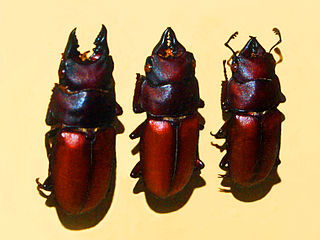
Prosopocoilus is a genus of beetles of the family Lucanidae.

Thornicroft's giraffe, also known as the Rhodesian giraffe or Luangwa giraffe, is a subspecies of giraffe. It is sometimes considered a species in its own right or a subspecies of the Masai giraffe. It is geographically isolated, occurring only in Zambia’s South Luangwa Valley. An estimated 550 live in the wild, with no captive populations. Its lifespan is 22 years for males and 28 years for females. The ecotype was originally named after Harry Scott Thornicroft, a commissioner in what was then North-Eastern Rhodesia and later Northern Rhodesia.

Sexual selection in mammals is a process the study of which started with Charles Darwin's observations concerning sexual selection, including sexual selection in humans, and in other mammals, consisting of male–male competition and mate choice that mold the development of future phenotypes in a population for a given species.
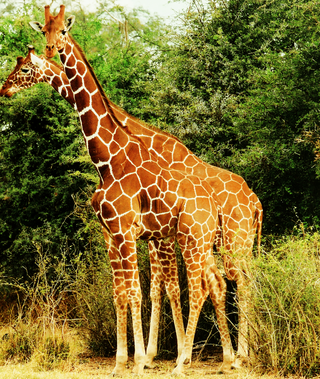
The reticulated giraffe is a species/subspecies of giraffe native to the Horn of Africa. It is differentiated from other types of giraffe by its coat, which consists of large, polygonal, block-like spots, which extend onto the lower legs, tail and face. These prominent liver-red spots also show much less white between them, when compared to other giraffe species. With up to 6 meters in height, the reticulated giraffe is the largest subspecies of giraffe and the largest land animal in general. While the reticulated giraffe may yet still be found in parts of its historic range, such as areas of Somalia and Ethiopia, its population stronghold is primarily within Kenya. There are approximately 8,500 individuals living in the wild. In both captivity and the wild, as of 2024 there are 15,785 individuals across the world.
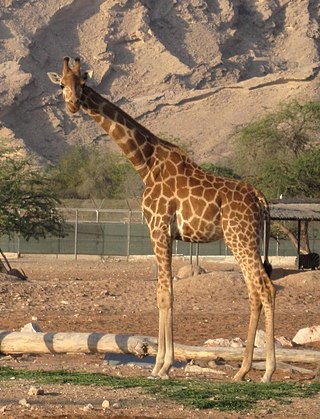
The Nubian giraffe, also known as Baringo giraffe or Ugandan giraffe, is the nominate subspecies or species of giraffe. It is found in Ethiopia, Kenya, Uganda, South Sudan and Sudan. It is currently extinct in the wild of the Democratic Republic of Congo, Egypt and Eritrea. The Nubian giraffe used to be widespread in northeast Africa. The subspecies was listed as Critically Endangered by the IUCN in 2018 for the first time due to a 95% decline in the past three decades.

The Angolan giraffe, also known as the Namibian giraffe or smokey giraffe, is a species or subspecies of giraffe that is found in northern Namibia, south-western Zambia, Botswana, western Zimbabwe and since mid-2023 again in Angola.

The southern giraffe, also known as two-horned giraffe, is a species of giraffe native to Southern Africa. However, the IUCN currently recognizes only one species of giraffe with nine subspecies.




















